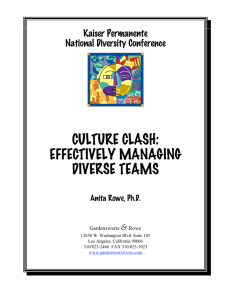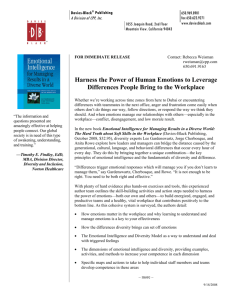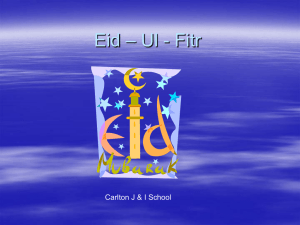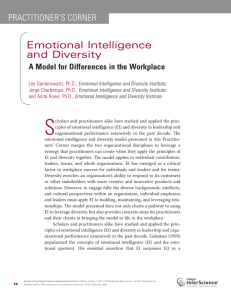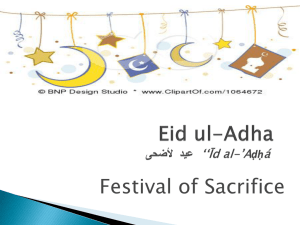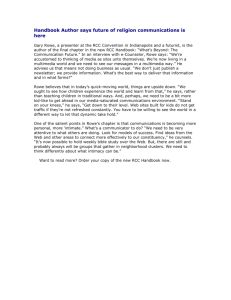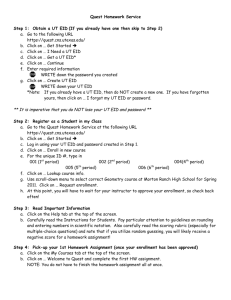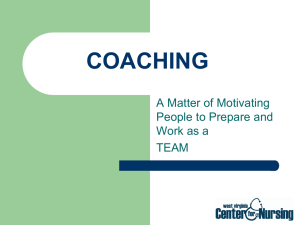W - Emotional Intelligence and Diversity Institute
advertisement
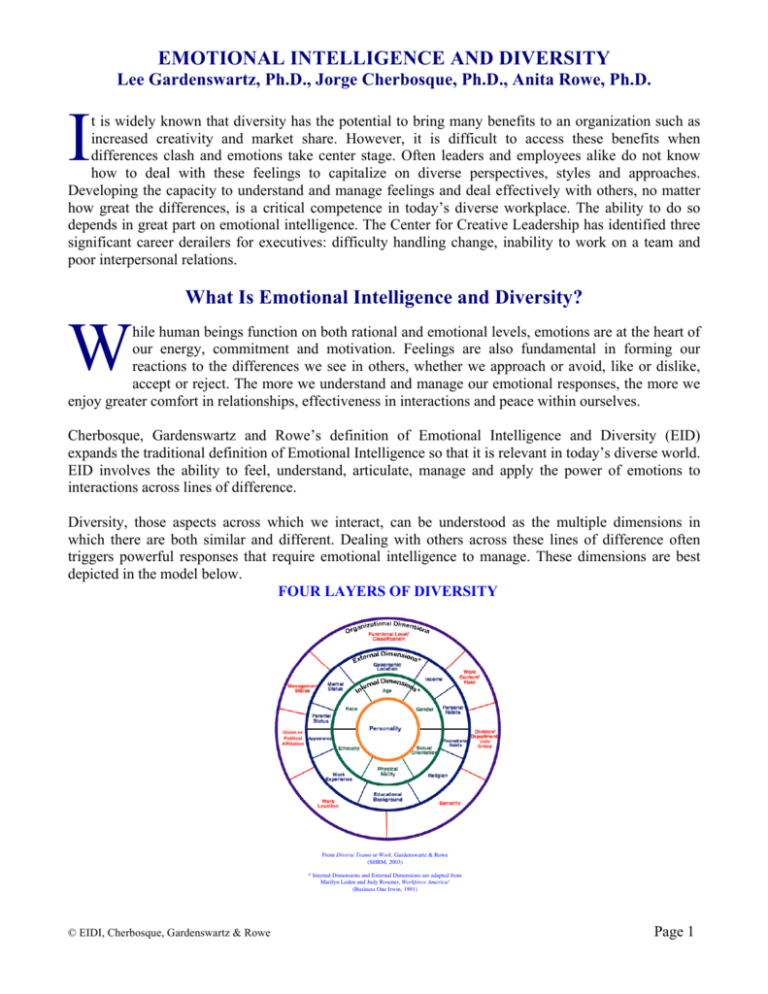
EMOTIONAL INTELLIGENCE AND DIVERSITY Lee Gardenswartz, Ph.D., Jorge Cherbosque, Ph.D., Anita Rowe, Ph.D. I t is widely known that diversity has the potential to bring many benefits to an organization such as increased creativity and market share. However, it is difficult to access these benefits when differences clash and emotions take center stage. Often leaders and employees alike do not know how to deal with these feelings to capitalize on diverse perspectives, styles and approaches. Developing the capacity to understand and manage feelings and deal effectively with others, no matter how great the differences, is a critical competence in today’s diverse workplace. The ability to do so depends in great part on emotional intelligence. The Center for Creative Leadership has identified three significant career derailers for executives: difficulty handling change, inability to work on a team and poor interpersonal relations. What Is Emotional Intelligence and Diversity? W hile human beings function on both rational and emotional levels, emotions are at the heart of our energy, commitment and motivation. Feelings are also fundamental in forming our reactions to the differences we see in others, whether we approach or avoid, like or dislike, accept or reject. The more we understand and manage our emotional responses, the more we enjoy greater comfort in relationships, effectiveness in interactions and peace within ourselves. Cherbosque, Gardenswartz and Rowe’s definition of Emotional Intelligence and Diversity (EID) expands the traditional definition of Emotional Intelligence so that it is relevant in today’s diverse world. EID involves the ability to feel, understand, articulate, manage and apply the power of emotions to interactions across lines of difference. Diversity, those aspects across which we interact, can be understood as the multiple dimensions in which there are both similar and different. Dealing with others across these lines of difference often triggers powerful responses that require emotional intelligence to manage. These dimensions are best depicted in the model below. FOUR LAYERS OF DIVERSITY FOUR LAYERS OF DIVERSITY Union or Political Affiliation From Diverse Teams at Work, Gardenswartz & Rowe (SHRM, 2003) * Internal Dimensions and External Dimensions are adapted from Marilyn Loden and Judy Rosener, Workforce America! (Business One Irwin, 1991) © EIDI, Cherbosque, Gardenswartz & Rowe Page 1 W hile Emotional Intelligence is needed to function effectively anywhere, additional aspects are required in a world where we are bombarded daily with differences, in areas such as values, language, behaviors, preferences and norms. Whether these unfamiliar ways are intriguing or confusing, frustrating or delightful, desirable or disagreeable, they touch us at a feeling level and produce an emotional as well as an intellectual response. These emotional reactions lead to behaviors that can be effective or ineffective depending on our ability to deal effectively with our feelings. The Emotional Intelligence we need to cope effectively in a diverse world involves both insight and action and focuses on both ourselves and others in order to have effective interactions and productive work groups. Emotional Intelligence and Diversity Affirmative Introspection A critical first step in developing the ability to deal with differences is an awareness of ourselves in order to understand our reactions to others. This involves a comfort with our own identity and an understanding of our values, passions, preferences and world view. It also involves becoming conscious of the biases and the assumptions that influence our attitudes toward others. • • • Knowing what makes me tick Being comfortable in my own skin Being in tune with my own biases and hot buttons Awareness precedes choice and understanding ourselves helps us predict our own behavior and know why we are reacting and feeling a particular way. This insight is fundamental to managing our emotional reactions and behavior toward others. © EIDI, Cherbosque, Gardenswartz & Rowe Page 2 Self-Governance Destructive behaviors sometimes occur when powerful feelings triggered by differences guide our actions. Our emotions are a powerful source of energy and once we understand the whys behind our reactions, the next step is developing the ability to manage them. That energy needs to be managed and channeled in a constructive direction. Self-Governance involves gaining mastery over the feelings that differences evoke by being able to deal with ambiguity that is part of a diverse environment, being flexible and • adaptable in the face of change and taking charge of the mental self • talk that goes on when we encounter challenging differences. • Often, the only control we have is over the messages we tell ourselves. Making ambiguity an ally Being my own change master Getting in charge of self-talk Intercultural Literacy • • • Understanding cultural whys behind behavior Seeing the benefits and limitations of all norms Transcending my own perspective (empathy) In a diverse world, understanding and managing ourselves is not enough. We also need to understand others in order to figure out the reasons and meaning behind their behavior. This third aspect involves understanding others’ cultural rules, norms, and values, and being able to empathize and metaphorically walk in their shoes. It also encompasses resisting the temptation to judge other’s behavior by our own standards and seeing the advantages and disadvantages of all cultural norms. This awareness and knowledge helps us to “read” the behavior of others more accurately so we can deal with them more effectively. Social Architecting The fourth component of EID focuses on developing the ability to consciously and intentionally structure our relationships and environments so that they are productive, fulfilling and satisfying for everyone. This arena of EID encompasses being able to serve as a cultural interpreter by helping others understand the different cultural norms and perspectives involved in situations. It also necessitates being able to resolve conflicts in ways that are mutually satisfying to all parties and creating welcoming, inclusive • environments that allow the creative potential of diversity to be realized. • • © EIDI, Cherbosque, Gardenswartz & Rowe Serving as a cultural interpreter Communicating effectively and resolving conflicts in diverse settings Structuring synergistic and compelling environments Page 3 Emotional Intelligence: Beyond the Individual Success, as an employee, manager or in any role in today’s diverse world requires us to develop competence in these four areas of Emotional Intelligence and Diversity so that we, as individuals and organizations, can be enriched by the diversity of our worlds. While the EID model has clear application and relevance for individuals, the same concepts apply to teams and organizations. Managers and team members alike share responsibility for building emotionally intelligent team environments. Leaders at the strategic level need to create policies and systems which reinforce and support the development and maintenance of emotionally intelligent organizations. Key Aspects at each level are: Individual level: • Developing the emotional intelligence competencies and skills individuals need to develop in order to function effectively in a diverse world Team level: • Developing the norms and skills needed to create emotionally intelligent teams that embrace diversity • Enabling teams to use diversity to create synergistic solutions within a joyful and respectful environment Organizational level: • Identifying the principles, norms and values that need to be developed, implemented, and communicated in order to become an emotionally intelligent organization that succeeds in a diverse world The four quadrants of EID apply at all three levels as illustrated in the figure below. While the individual application has been discussed in the earlier sections of this article, relevance at the team and organizational levels is discussed in the next section. © EIDI, Cherbosque, Gardenswartz & Rowe Page 4 ORGANIZATON TEAM INDIVIDUAL Team Level The promise of dealing with differences tantalizes people eliciting interest and curiosity. The difficulty comes when team members from different backgrounds, value sets and styles have to work together and deal with the conflicting aspects of these differences. In the process of making changes and operationalizing policies and procedures, they sometimes find that real differences are no longer so full of promise. They are just difficult. It is here where EID can be of immense help. For any team that wants to achieve productivity, meaning and joy in this complex pluralistic world, EID provides an approach to creating and reinforcing healthy norms. A key question is, how, amid all these sometimes brilliant and at other times potentially irritating differences, can a team function well and productively together? Skills, competencies and norms for creating teams that embrace differences in style, priorities, viewpoints, skills and talents are needed at the team level. Ground rules about how to give feedback in constructive ways is the beginning discussion point. Perhaps people agree that any feedback must be about a behavior than can be changed and presented through the “I” message technique which guarantees less judgment and defensiveness (e.g., “I get irritated when I am interrupted when I try to give my ideas.”). Perhaps the team designs fun but pointed ways to give people feedback when old habits are hard to break. For example, in one group, team members yelled “Boomerang” when norms were violated. That comment signaled that the behavior could come around to kick you if you keep it up. This is a light, easy way to help break bad habits. Through intentionally focusing on creating and reinforcing such norms, EID helps team members manage potentially disruptive experiences in a productive way and use conflict as a stimulus for creativity and growth. © EIDI, Cherbosque, Gardenswartz & Rowe Page 5 Organizational Level At the organizational level, creating an Emotional Intelligent work environment involves creating a balance between creating shared organizational values and honoring individual uniqueness. How does the organization manage work life/balance needs with productivity goals and deadlines? How can employees’ needs for honest, direct communication and transparency be met in a climate of rapid change? How does the organization live its stated values of integrity and honesty? These issues involve real feedback…good dialogue…important conversations without retribution…the desire to have the organization actually value time spent in soft skills so people can communicate without hurting each other. A chance to walk the talk may occur during a difficult period involving layoffs. That is a time when clarity and transparency, though difficult, go a long way toward demonstrating honesty. Another example would be organizations rewarding risk taking, regardless of the outcome, with the victory not in the result but in taking the risk itself. EID in organizations is focused on helping employees achieve a joyful, productive and meaningful life so they give their best to the organization, their customers and their communities. A workplace governed by intentional acts enriched by purpose, contributions and meaning is the dream. EID can contribute to making it your reality. EXAMPLES OF NORMS AND ACTIONS THAT FOSTER PRODUCTIVE WORK RELATIONSHIPS THE EID WAY The following chart offers examples of actions that, if taken to at an individual, team and organizational level, can enable employees to create a productive, meaningful, joyous work life. These are examples of some of the possibilities. Each organization needs to establish the behaviors that it believes will enable it to achieve an organizational culture rich in purpose, accomplishment, meaning, mutual respect, connection and joy. INDIVIDUAL • • AFFIRMATIVE INTROSPECTION Be honest with yourself about your reactions, feelings and values. Tell your teammates what you are thinking and how you are feeling in a tactful way. • Be aware of your hot buttons and assumptions. • When you have a strong reaction to a situation or another’s behavior, ask yourself why. © EIDI, Cherbosque, Gardenswartz & Rowe TEAM • Make time on a routine basis to assess team effectiveness to and give and receive feedback. • Pay as much attention to process as task. • Be willing to comment on team dynamics and processes in a nonjudgmental, objective way. ORGANIZATION • Tell inspirational stories about the organization's heritage and heroes. • Have conversations about whether proposed actions and policies are consistent with the organizations values and culture. Page 6 EXAMPLES OF NORMS AND ACTIONS THAT FOSTER PRODUCTIVE WORK RELATIONSHIPS THE EID WAY (continued) INDIVIDUAL SELF-GOVERNANCE • Put yourself in new and unfamiliar environments. • Avoid finger pointing and blaming. • Seek and be open to the feedback and opinions of others while managing the potential to become defensive. • • Teach yourself to respond to differences with curiosity by asking questions rather than getting defensive. • Manage frustration and anger by reframing situations and changing self talk messages. • Assume that difficult behavior takes place for a reason and find out what the reason is. • INTERCULTURAL LITERACY Develop ways to help yourself cope with ambiguity. Reach out to those who are different to expand your understanding. • Avoid negative attributions about others’ behavior. • Invest time in understanding your own assumptions about other’s behaviors as a way to improve relationships. © EIDI, Cherbosque, Gardenswartz & Rowe TEAM ORGANIZATION • Set ground rules among group members. • Define the work climate the group wants to have with members of the group. • Acknowledge gains, losses and opportunities in changes. • Avoid polarized, either-or thinking by always creating more than two options. • Make fun a priority in the culture. • Build in fun ways to enhance the enjoyment of work and alleviate stress. • Respect, understand and value differences in both individual styles and perspectives. Solicit information about the needs and concerns of employees from all parts of the organization. • Take time to hear and understand all views. Create opportunities for cross training. • As a team, identify concrete behaviors that are indicators of trust and integrity. Clarify the behaviors and results employees will be held accountable for. • Come up with a creative, nonthreatening way and language that make discussing difficult issues easier. • • • • • Help people navigate the process of change by identifying the controllable aspects. Identify and share hot buttons for team members. Page 7 INDIVIDUAL • • • SOCIAL ARCHITECTING • • Seek resolutions that are mutually satisfying. Spend time building relationships with people different from you. Invite those who are quiet and less verbal to express ideas and opinions Validate colleagues and their contributions. TEAM • Check in with people at the beginning of a meeting to find out how everyone is doing. • Make the “check in” a regular part of the meetings. • Invite other departments to your team meetings and attend theirs. • Ask client departments for feedback. • Offer alternatives when existing processes are not working. • Invite all participants to engage in the design of processes that involve the most reluctant members. Express gratitude to others on a regular basis. • © EIDI, Cherbosque, Gardenswartz & Rowe Make certain that potentially divisive issues get talked about in a constructive dialogue. ORGANIZATION • Affirm a respectful workplace by setting organizational ground rules that foster respect such as “Each employee is safe from ridicule and humiliation.” • Create forums for interdepartmental sharing and problem solving. • Create vehicles for contact and communication across the organization. • Create roles, such as ombudsperson or diversity director and give them power and resources. Page 8
